Business Decision Making
VerifiedAdded on 2023/01/04
|13
|2510
|45
AI Summary
This document discusses various concepts related to business decision making, such as mean, median, mode, range, variance, standard deviation, critical path, payback period, non-discounted cash flow, accounting rate of return, net present value, and internal rate of return. It provides explanations and examples for each concept, highlighting their importance in financial decision making. The document also discusses the advantages and disadvantages of different evaluation methods. Overall, it offers a comprehensive overview of business decision making.
Contribute Materials
Your contribution can guide someone’s learning journey. Share your
documents today.

BUSINESS DECISION
MAKING
MAKING
Secure Best Marks with AI Grader
Need help grading? Try our AI Grader for instant feedback on your assignments.

Contents
TASK..................................................................................................................................3
Question 1.................................................................................................................3
Question 2.................................................................................................................3
Question 3.................................................................................................................5
Question 4.................................................................................................................5
Question 5...............................................................................................................................5
Question 6...............................................................................................................................7
TASK..................................................................................................................................3
Question 1.................................................................................................................3
Question 2.................................................................................................................3
Question 3.................................................................................................................5
Question 4.................................................................................................................5
Question 5...............................................................................................................................5
Question 6...............................................................................................................................7
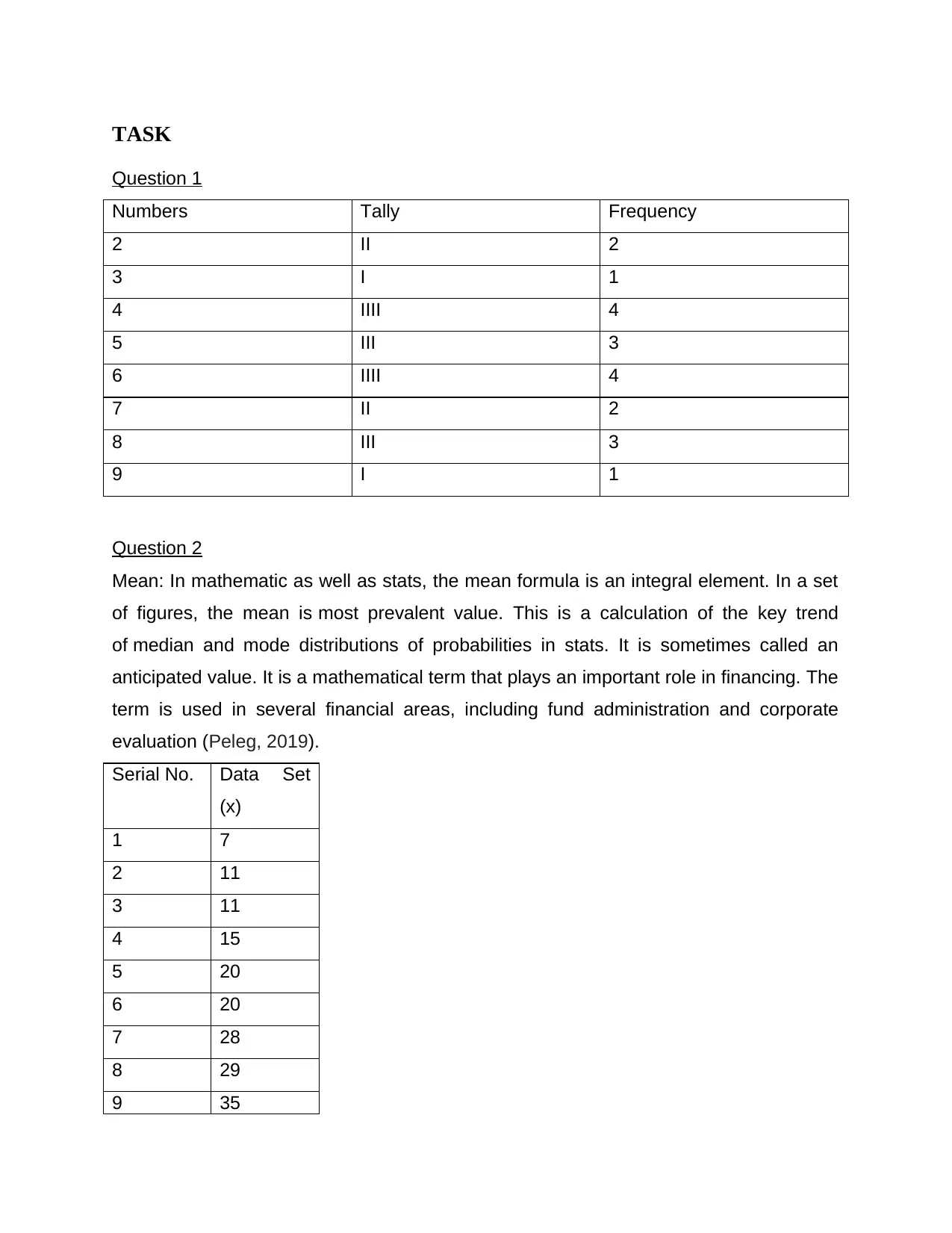
TASK
Question 1
Numbers Tally Frequency
2 II 2
3 I 1
4 IIII 4
5 III 3
6 IIII 4
7 II 2
8 III 3
9 I 1
Question 2
Mean: In mathematic as well as stats, the mean formula is an integral element. In a set
of figures, the mean is most prevalent value. This is a calculation of the key trend
of median and mode distributions of probabilities in stats. It is sometimes called an
anticipated value. It is a mathematical term that plays an important role in financing. The
term is used in several financial areas, including fund administration and corporate
evaluation (Peleg, 2019).
Serial No. Data Set
(x)
1 7
2 11
3 11
4 15
5 20
6 20
7 28
8 29
9 35
Question 1
Numbers Tally Frequency
2 II 2
3 I 1
4 IIII 4
5 III 3
6 IIII 4
7 II 2
8 III 3
9 I 1
Question 2
Mean: In mathematic as well as stats, the mean formula is an integral element. In a set
of figures, the mean is most prevalent value. This is a calculation of the key trend
of median and mode distributions of probabilities in stats. It is sometimes called an
anticipated value. It is a mathematical term that plays an important role in financing. The
term is used in several financial areas, including fund administration and corporate
evaluation (Peleg, 2019).
Serial No. Data Set
(x)
1 7
2 11
3 11
4 15
5 20
6 20
7 28
8 29
9 35
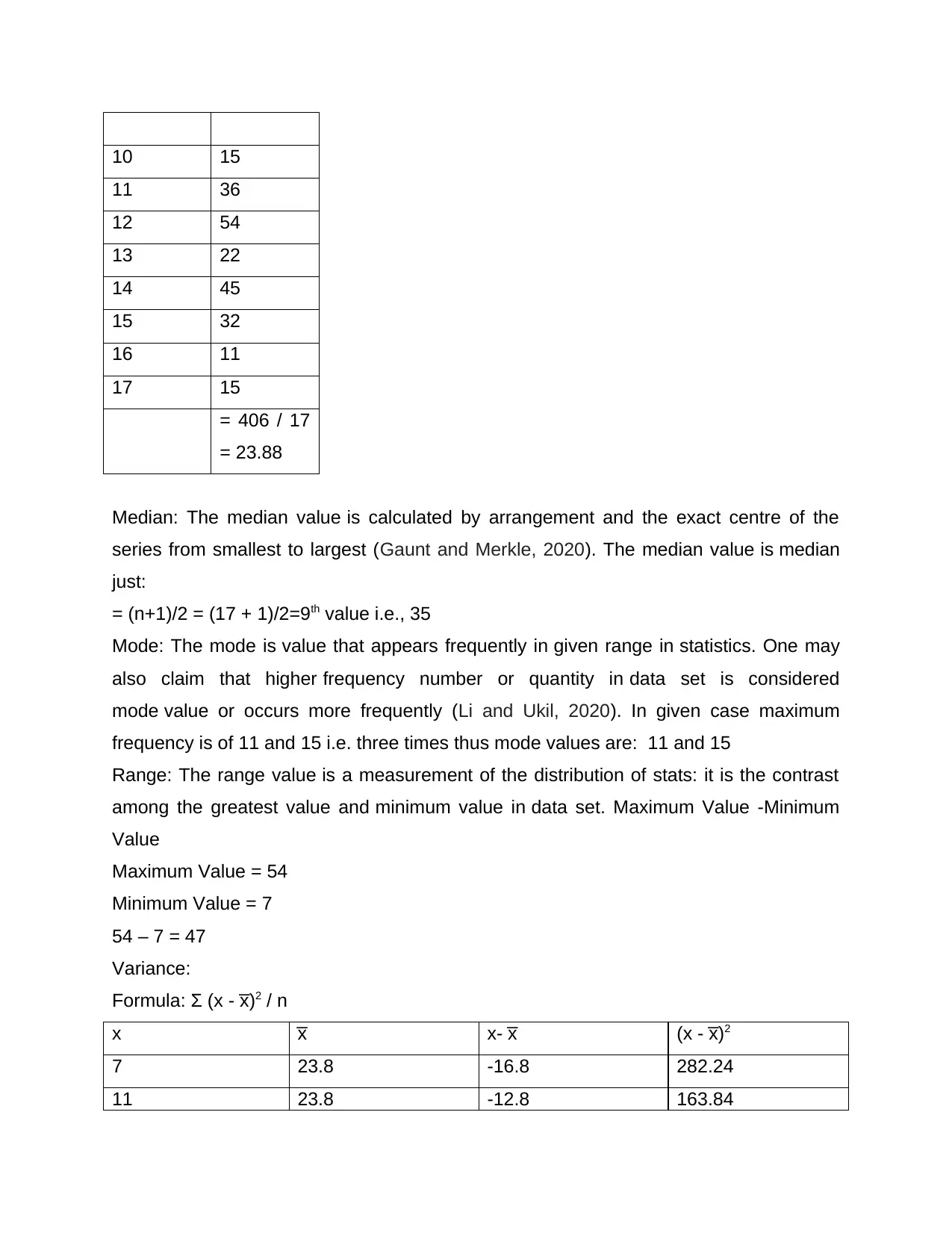
10 15
11 36
12 54
13 22
14 45
15 32
16 11
17 15
= 406 / 17
= 23.88
Median: The median value is calculated by arrangement and the exact centre of the
series from smallest to largest (Gaunt and Merkle, 2020). The median value is median
just:
= (n+1)/2 = (17 + 1)/2=9th value i.e., 35
Mode: The mode is value that appears frequently in given range in statistics. One may
also claim that higher frequency number or quantity in data set is considered
mode value or occurs more frequently (Li and Ukil, 2020). In given case maximum
frequency is of 11 and 15 i.e. three times thus mode values are: 11 and 15
Range: The range value is a measurement of the distribution of stats: it is the contrast
among the greatest value and minimum value in data set. Maximum Value -Minimum
Value
Maximum Value = 54
Minimum Value = 7
54 – 7 = 47
Variance:
Formula: Σ (x - x̅)2 / n
x x̅ x- x̅ (x - x̅)2
7 23.8 -16.8 282.24
11 23.8 -12.8 163.84
11 36
12 54
13 22
14 45
15 32
16 11
17 15
= 406 / 17
= 23.88
Median: The median value is calculated by arrangement and the exact centre of the
series from smallest to largest (Gaunt and Merkle, 2020). The median value is median
just:
= (n+1)/2 = (17 + 1)/2=9th value i.e., 35
Mode: The mode is value that appears frequently in given range in statistics. One may
also claim that higher frequency number or quantity in data set is considered
mode value or occurs more frequently (Li and Ukil, 2020). In given case maximum
frequency is of 11 and 15 i.e. three times thus mode values are: 11 and 15
Range: The range value is a measurement of the distribution of stats: it is the contrast
among the greatest value and minimum value in data set. Maximum Value -Minimum
Value
Maximum Value = 54
Minimum Value = 7
54 – 7 = 47
Variance:
Formula: Σ (x - x̅)2 / n
x x̅ x- x̅ (x - x̅)2
7 23.8 -16.8 282.24
11 23.8 -12.8 163.84
Secure Best Marks with AI Grader
Need help grading? Try our AI Grader for instant feedback on your assignments.
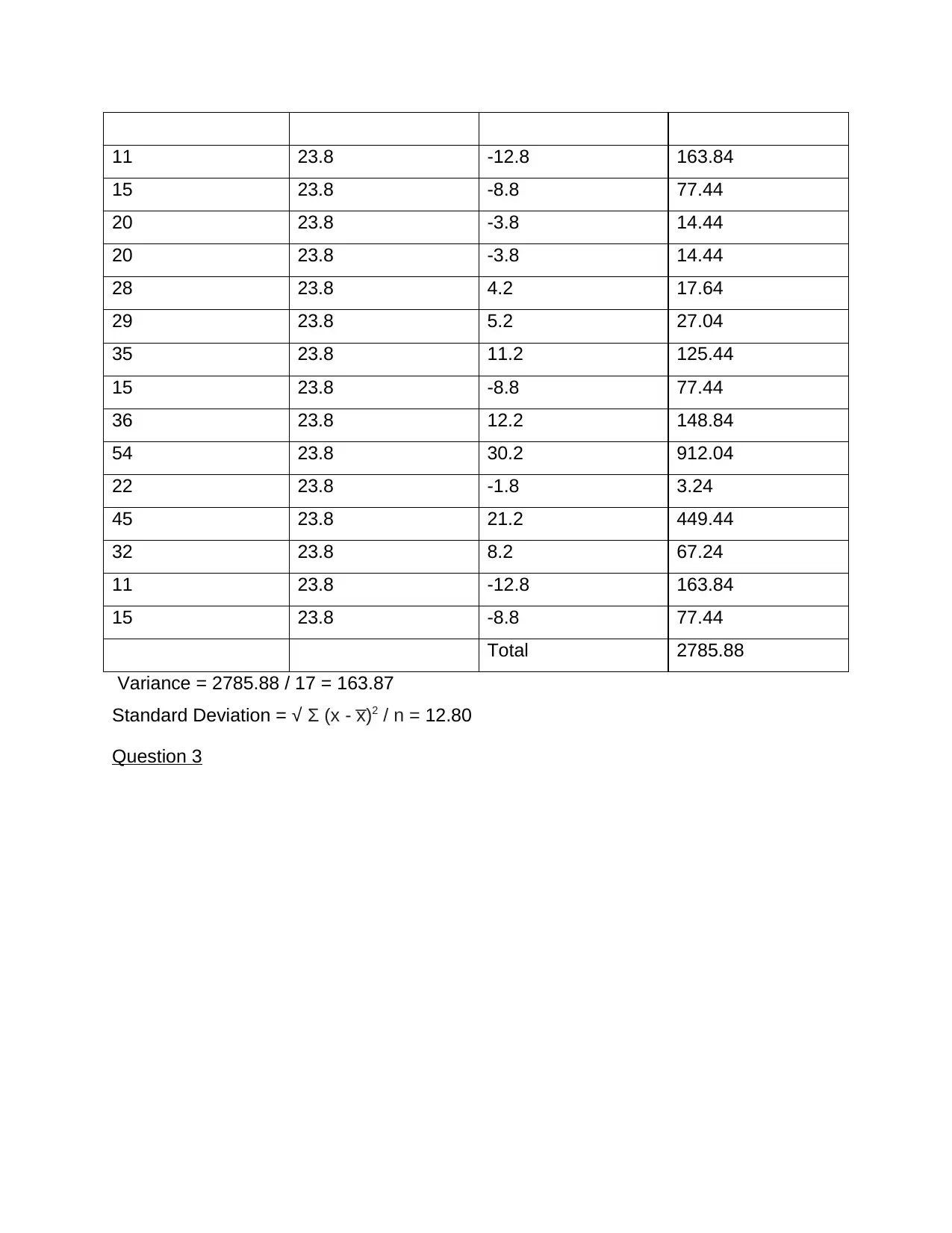
11 23.8 -12.8 163.84
15 23.8 -8.8 77.44
20 23.8 -3.8 14.44
20 23.8 -3.8 14.44
28 23.8 4.2 17.64
29 23.8 5.2 27.04
35 23.8 11.2 125.44
15 23.8 -8.8 77.44
36 23.8 12.2 148.84
54 23.8 30.2 912.04
22 23.8 -1.8 3.24
45 23.8 21.2 449.44
32 23.8 8.2 67.24
11 23.8 -12.8 163.84
15 23.8 -8.8 77.44
Total 2785.88
Variance = 2785.88 / 17 = 163.87
Standard Deviation = √ Σ (x - x̅)2 / n = 12.80
Question 3
15 23.8 -8.8 77.44
20 23.8 -3.8 14.44
20 23.8 -3.8 14.44
28 23.8 4.2 17.64
29 23.8 5.2 27.04
35 23.8 11.2 125.44
15 23.8 -8.8 77.44
36 23.8 12.2 148.84
54 23.8 30.2 912.04
22 23.8 -1.8 3.24
45 23.8 21.2 449.44
32 23.8 8.2 67.24
11 23.8 -12.8 163.84
15 23.8 -8.8 77.44
Total 2785.88
Variance = 2785.88 / 17 = 163.87
Standard Deviation = √ Σ (x - x̅)2 / n = 12.80
Question 3
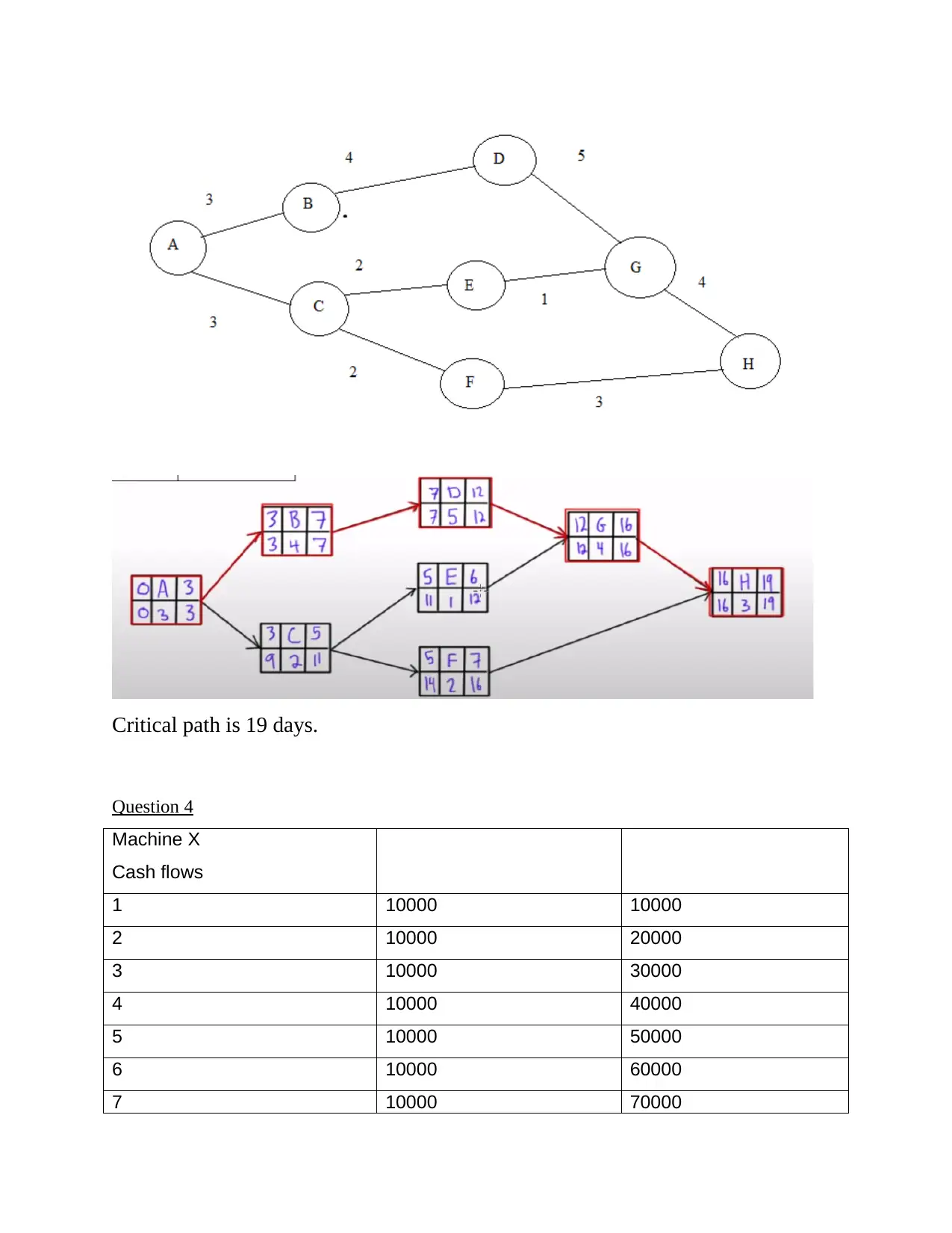
Critical path is 19 days.
Question 4
Machine X
Cash flows
1 10000 10000
2 10000 20000
3 10000 30000
4 10000 40000
5 10000 50000
6 10000 60000
7 10000 70000
Question 4
Machine X
Cash flows
1 10000 10000
2 10000 20000
3 10000 30000
4 10000 40000
5 10000 50000
6 10000 60000
7 10000 70000
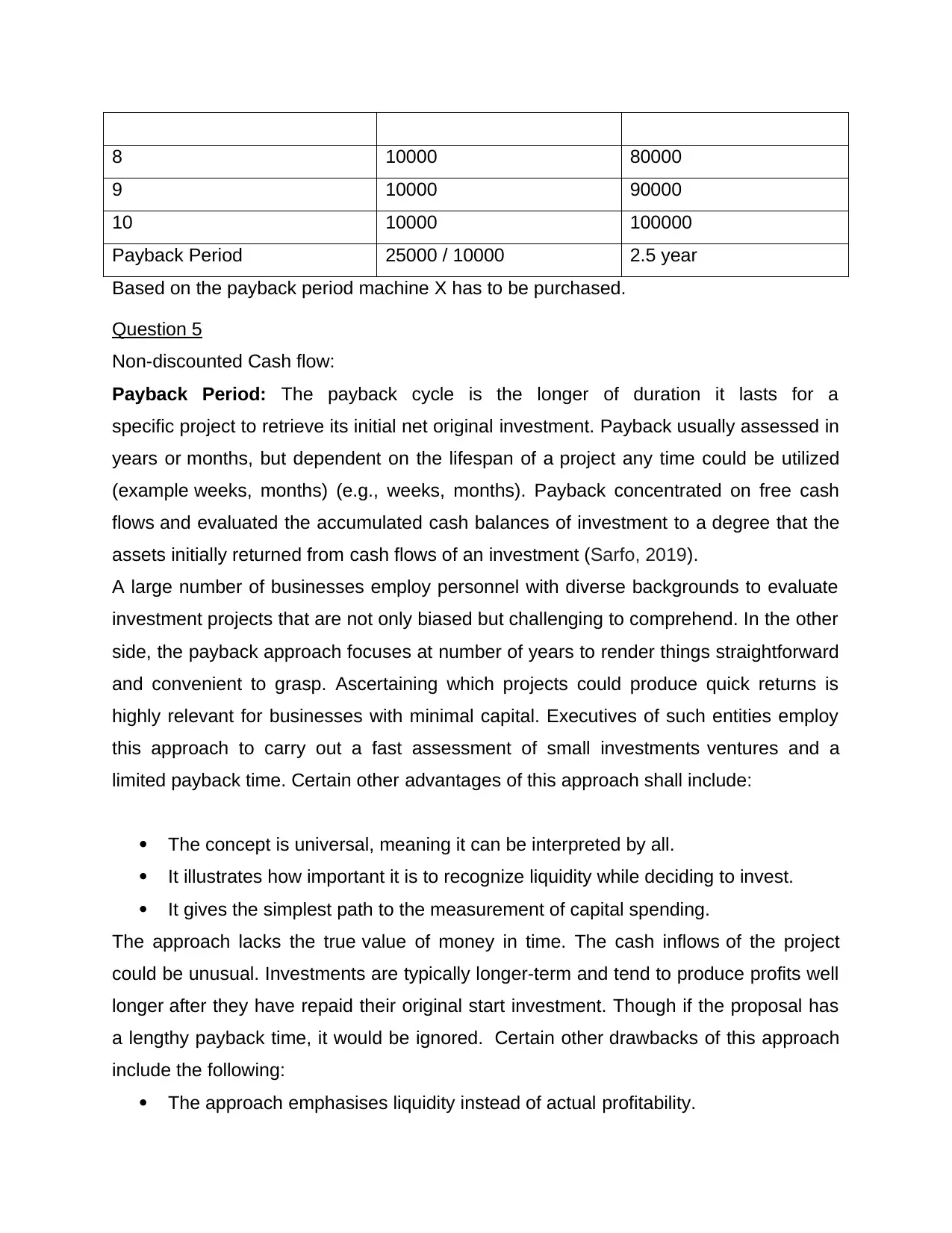
8 10000 80000
9 10000 90000
10 10000 100000
Payback Period 25000 / 10000 2.5 year
Based on the payback period machine X has to be purchased.
Question 5
Non-discounted Cash flow:
Payback Period: The payback cycle is the longer of duration it lasts for a
specific project to retrieve its initial net original investment. Payback usually assessed in
years or months, but dependent on the lifespan of a project any time could be utilized
(example weeks, months) (e.g., weeks, months). Payback concentrated on free cash
flows and evaluated the accumulated cash balances of investment to a degree that the
assets initially returned from cash flows of an investment (Sarfo, 2019).
A large number of businesses employ personnel with diverse backgrounds to evaluate
investment projects that are not only biased but challenging to comprehend. In the other
side, the payback approach focuses at number of years to render things straightforward
and convenient to grasp. Ascertaining which projects could produce quick returns is
highly relevant for businesses with minimal capital. Executives of such entities employ
this approach to carry out a fast assessment of small investments ventures and a
limited payback time. Certain other advantages of this approach shall include:
The concept is universal, meaning it can be interpreted by all.
It illustrates how important it is to recognize liquidity while deciding to invest.
It gives the simplest path to the measurement of capital spending.
The approach lacks the true value of money in time. The cash inflows of the project
could be unusual. Investments are typically longer-term and tend to produce profits well
longer after they have repaid their original start investment. Though if the proposal has
a lengthy payback time, it would be ignored. Certain other drawbacks of this approach
include the following:
The approach emphasises liquidity instead of actual profitability.
9 10000 90000
10 10000 100000
Payback Period 25000 / 10000 2.5 year
Based on the payback period machine X has to be purchased.
Question 5
Non-discounted Cash flow:
Payback Period: The payback cycle is the longer of duration it lasts for a
specific project to retrieve its initial net original investment. Payback usually assessed in
years or months, but dependent on the lifespan of a project any time could be utilized
(example weeks, months) (e.g., weeks, months). Payback concentrated on free cash
flows and evaluated the accumulated cash balances of investment to a degree that the
assets initially returned from cash flows of an investment (Sarfo, 2019).
A large number of businesses employ personnel with diverse backgrounds to evaluate
investment projects that are not only biased but challenging to comprehend. In the other
side, the payback approach focuses at number of years to render things straightforward
and convenient to grasp. Ascertaining which projects could produce quick returns is
highly relevant for businesses with minimal capital. Executives of such entities employ
this approach to carry out a fast assessment of small investments ventures and a
limited payback time. Certain other advantages of this approach shall include:
The concept is universal, meaning it can be interpreted by all.
It illustrates how important it is to recognize liquidity while deciding to invest.
It gives the simplest path to the measurement of capital spending.
The approach lacks the true value of money in time. The cash inflows of the project
could be unusual. Investments are typically longer-term and tend to produce profits well
longer after they have repaid their original start investment. Though if the proposal has
a lengthy payback time, it would be ignored. Certain other drawbacks of this approach
include the following:
The approach emphasises liquidity instead of actual profitability.
Paraphrase This Document
Need a fresh take? Get an instant paraphrase of this document with our AI Paraphraser
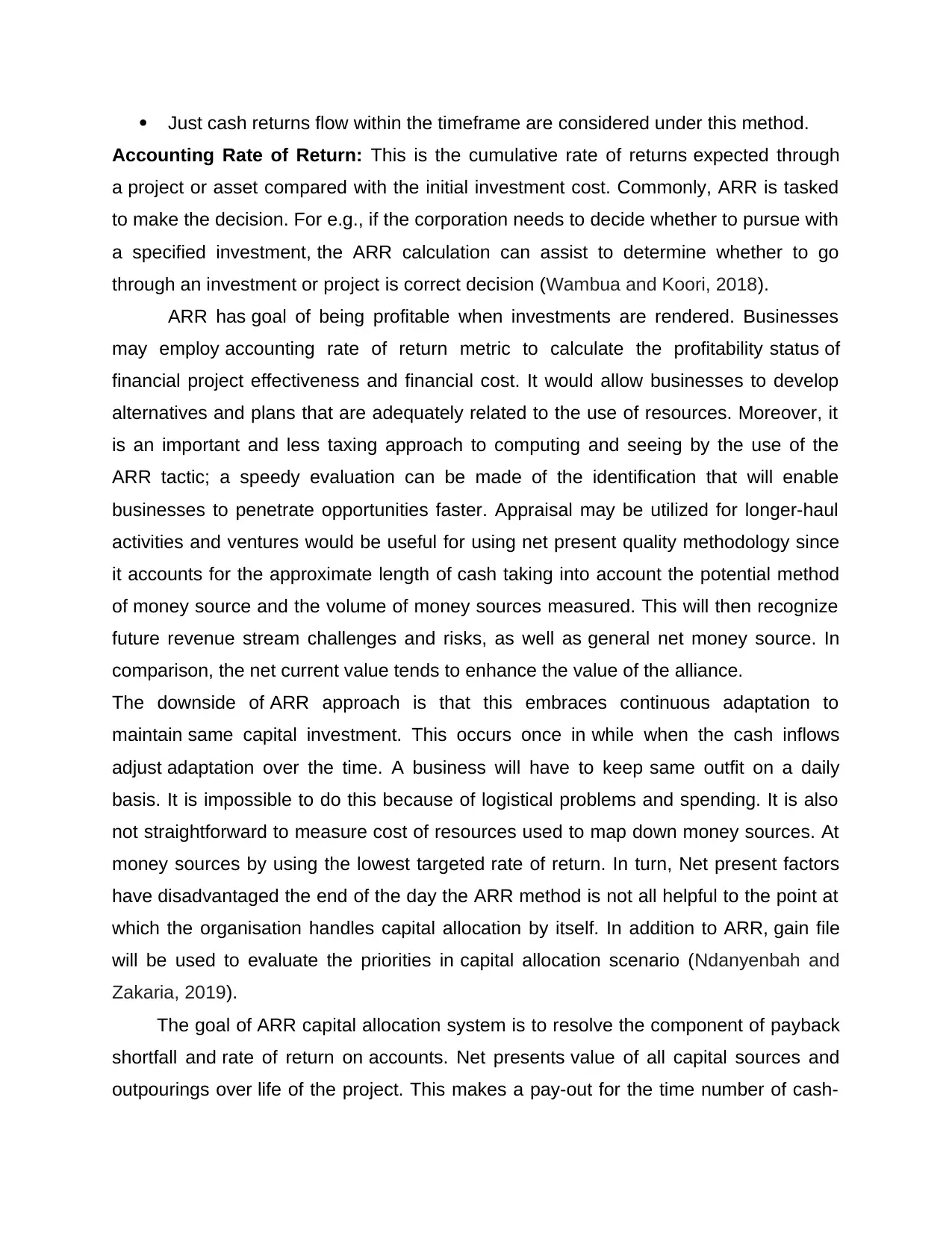
Just cash returns flow within the timeframe are considered under this method.
Accounting Rate of Return: This is the cumulative rate of returns expected through
a project or asset compared with the initial investment cost. Commonly, ARR is tasked
to make the decision. For e.g., if the corporation needs to decide whether to pursue with
a specified investment, the ARR calculation can assist to determine whether to go
through an investment or project is correct decision (Wambua and Koori, 2018).
ARR has goal of being profitable when investments are rendered. Businesses
may employ accounting rate of return metric to calculate the profitability status of
financial project effectiveness and financial cost. It would allow businesses to develop
alternatives and plans that are adequately related to the use of resources. Moreover, it
is an important and less taxing approach to computing and seeing by the use of the
ARR tactic; a speedy evaluation can be made of the identification that will enable
businesses to penetrate opportunities faster. Appraisal may be utilized for longer-haul
activities and ventures would be useful for using net present quality methodology since
it accounts for the approximate length of cash taking into account the potential method
of money source and the volume of money sources measured. This will then recognize
future revenue stream challenges and risks, as well as general net money source. In
comparison, the net current value tends to enhance the value of the alliance.
The downside of ARR approach is that this embraces continuous adaptation to
maintain same capital investment. This occurs once in while when the cash inflows
adjust adaptation over the time. A business will have to keep same outfit on a daily
basis. It is impossible to do this because of logistical problems and spending. It is also
not straightforward to measure cost of resources used to map down money sources. At
money sources by using the lowest targeted rate of return. In turn, Net present factors
have disadvantaged the end of the day the ARR method is not all helpful to the point at
which the organisation handles capital allocation by itself. In addition to ARR, gain file
will be used to evaluate the priorities in capital allocation scenario (Ndanyenbah and
Zakaria, 2019).
The goal of ARR capital allocation system is to resolve the component of payback
shortfall and rate of return on accounts. Net presents value of all capital sources and
outpourings over life of the project. This makes a pay-out for the time number of cash-
Accounting Rate of Return: This is the cumulative rate of returns expected through
a project or asset compared with the initial investment cost. Commonly, ARR is tasked
to make the decision. For e.g., if the corporation needs to decide whether to pursue with
a specified investment, the ARR calculation can assist to determine whether to go
through an investment or project is correct decision (Wambua and Koori, 2018).
ARR has goal of being profitable when investments are rendered. Businesses
may employ accounting rate of return metric to calculate the profitability status of
financial project effectiveness and financial cost. It would allow businesses to develop
alternatives and plans that are adequately related to the use of resources. Moreover, it
is an important and less taxing approach to computing and seeing by the use of the
ARR tactic; a speedy evaluation can be made of the identification that will enable
businesses to penetrate opportunities faster. Appraisal may be utilized for longer-haul
activities and ventures would be useful for using net present quality methodology since
it accounts for the approximate length of cash taking into account the potential method
of money source and the volume of money sources measured. This will then recognize
future revenue stream challenges and risks, as well as general net money source. In
comparison, the net current value tends to enhance the value of the alliance.
The downside of ARR approach is that this embraces continuous adaptation to
maintain same capital investment. This occurs once in while when the cash inflows
adjust adaptation over the time. A business will have to keep same outfit on a daily
basis. It is impossible to do this because of logistical problems and spending. It is also
not straightforward to measure cost of resources used to map down money sources. At
money sources by using the lowest targeted rate of return. In turn, Net present factors
have disadvantaged the end of the day the ARR method is not all helpful to the point at
which the organisation handles capital allocation by itself. In addition to ARR, gain file
will be used to evaluate the priorities in capital allocation scenario (Ndanyenbah and
Zakaria, 2019).
The goal of ARR capital allocation system is to resolve the component of payback
shortfall and rate of return on accounts. Net presents value of all capital sources and
outpourings over life of the project. This makes a pay-out for the time number of cash-
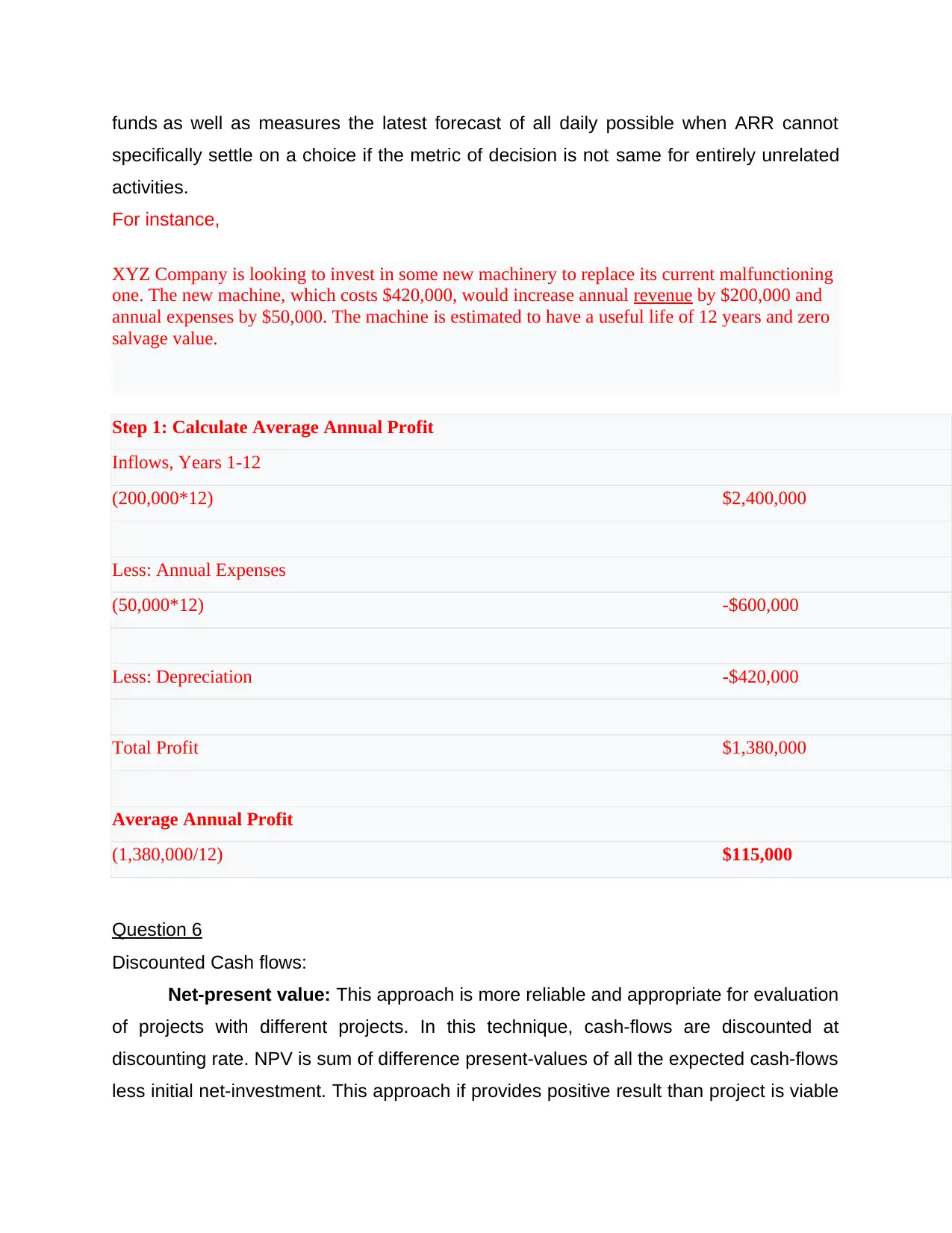
funds as well as measures the latest forecast of all daily possible when ARR cannot
specifically settle on a choice if the metric of decision is not same for entirely unrelated
activities.
For instance,
XYZ Company is looking to invest in some new machinery to replace its current malfunctioning
one. The new machine, which costs $420,000, would increase annual revenue by $200,000 and
annual expenses by $50,000. The machine is estimated to have a useful life of 12 years and zero
salvage value.
Step 1: Calculate Average Annual Profit
Inflows, Years 1-12
(200,000*12) $2,400,000
Less: Annual Expenses
(50,000*12) -$600,000
Less: Depreciation -$420,000
Total Profit $1,380,000
Average Annual Profit
(1,380,000/12) $115,000
Question 6
Discounted Cash flows:
Net-present value: This approach is more reliable and appropriate for evaluation
of projects with different projects. In this technique, cash-flows are discounted at
discounting rate. NPV is sum of difference present-values of all the expected cash-flows
less initial net-investment. This approach if provides positive result than project is viable
specifically settle on a choice if the metric of decision is not same for entirely unrelated
activities.
For instance,
XYZ Company is looking to invest in some new machinery to replace its current malfunctioning
one. The new machine, which costs $420,000, would increase annual revenue by $200,000 and
annual expenses by $50,000. The machine is estimated to have a useful life of 12 years and zero
salvage value.
Step 1: Calculate Average Annual Profit
Inflows, Years 1-12
(200,000*12) $2,400,000
Less: Annual Expenses
(50,000*12) -$600,000
Less: Depreciation -$420,000
Total Profit $1,380,000
Average Annual Profit
(1,380,000/12) $115,000
Question 6
Discounted Cash flows:
Net-present value: This approach is more reliable and appropriate for evaluation
of projects with different projects. In this technique, cash-flows are discounted at
discounting rate. NPV is sum of difference present-values of all the expected cash-flows
less initial net-investment. This approach if provides positive result than project is viable
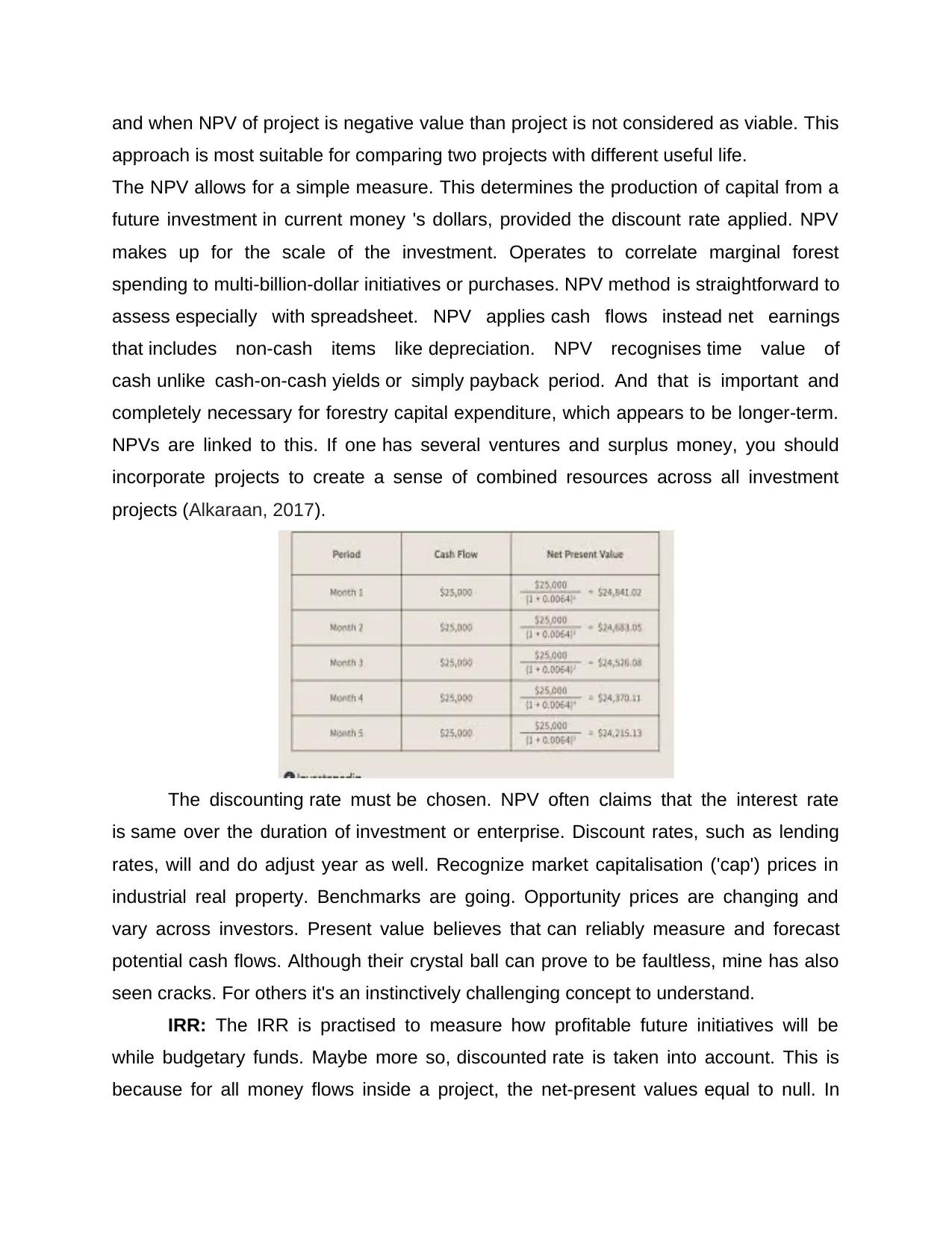
and when NPV of project is negative value than project is not considered as viable. This
approach is most suitable for comparing two projects with different useful life.
The NPV allows for a simple measure. This determines the production of capital from a
future investment in current money 's dollars, provided the discount rate applied. NPV
makes up for the scale of the investment. Operates to correlate marginal forest
spending to multi-billion-dollar initiatives or purchases. NPV method is straightforward to
assess especially with spreadsheet. NPV applies cash flows instead net earnings
that includes non-cash items like depreciation. NPV recognises time value of
cash unlike cash-on-cash yields or simply payback period. And that is important and
completely necessary for forestry capital expenditure, which appears to be longer-term.
NPVs are linked to this. If one has several ventures and surplus money, you should
incorporate projects to create a sense of combined resources across all investment
projects (Alkaraan, 2017).
The discounting rate must be chosen. NPV often claims that the interest rate
is same over the duration of investment or enterprise. Discount rates, such as lending
rates, will and do adjust year as well. Recognize market capitalisation ('cap') prices in
industrial real property. Benchmarks are going. Opportunity prices are changing and
vary across investors. Present value believes that can reliably measure and forecast
potential cash flows. Although their crystal ball can prove to be faultless, mine has also
seen cracks. For others it's an instinctively challenging concept to understand.
IRR: The IRR is practised to measure how profitable future initiatives will be
while budgetary funds. Maybe more so, discounted rate is taken into account. This is
because for all money flows inside a project, the net-present values equal to null. In
approach is most suitable for comparing two projects with different useful life.
The NPV allows for a simple measure. This determines the production of capital from a
future investment in current money 's dollars, provided the discount rate applied. NPV
makes up for the scale of the investment. Operates to correlate marginal forest
spending to multi-billion-dollar initiatives or purchases. NPV method is straightforward to
assess especially with spreadsheet. NPV applies cash flows instead net earnings
that includes non-cash items like depreciation. NPV recognises time value of
cash unlike cash-on-cash yields or simply payback period. And that is important and
completely necessary for forestry capital expenditure, which appears to be longer-term.
NPVs are linked to this. If one has several ventures and surplus money, you should
incorporate projects to create a sense of combined resources across all investment
projects (Alkaraan, 2017).
The discounting rate must be chosen. NPV often claims that the interest rate
is same over the duration of investment or enterprise. Discount rates, such as lending
rates, will and do adjust year as well. Recognize market capitalisation ('cap') prices in
industrial real property. Benchmarks are going. Opportunity prices are changing and
vary across investors. Present value believes that can reliably measure and forecast
potential cash flows. Although their crystal ball can prove to be faultless, mine has also
seen cracks. For others it's an instinctively challenging concept to understand.
IRR: The IRR is practised to measure how profitable future initiatives will be
while budgetary funds. Maybe more so, discounted rate is taken into account. This is
because for all money flows inside a project, the net-present values equal to null. In
Secure Best Marks with AI Grader
Need help grading? Try our AI Grader for instant feedback on your assignments.
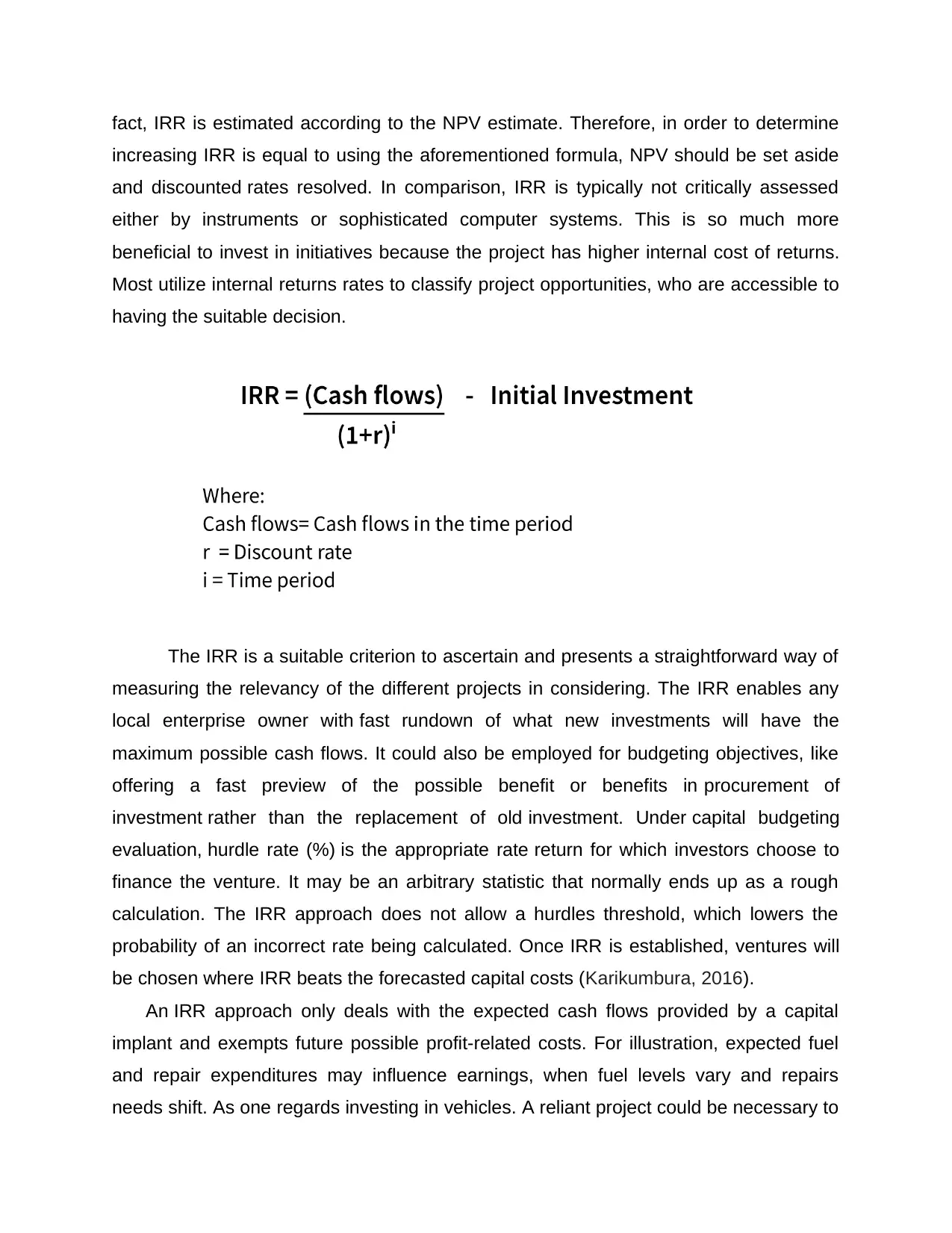
fact, IRR is estimated according to the NPV estimate. Therefore, in order to determine
increasing IRR is equal to using the aforementioned formula, NPV should be set aside
and discounted rates resolved. In comparison, IRR is typically not critically assessed
either by instruments or sophisticated computer systems. This is so much more
beneficial to invest in initiatives because the project has higher internal cost of returns.
Most utilize internal returns rates to classify project opportunities, who are accessible to
having the suitable decision.
The IRR is a suitable criterion to ascertain and presents a straightforward way of
measuring the relevancy of the different projects in considering. The IRR enables any
local enterprise owner with fast rundown of what new investments will have the
maximum possible cash flows. It could also be employed for budgeting objectives, like
offering a fast preview of the possible benefit or benefits in procurement of
investment rather than the replacement of old investment. Under capital budgeting
evaluation, hurdle rate (%) is the appropriate rate return for which investors choose to
finance the venture. It may be an arbitrary statistic that normally ends up as a rough
calculation. The IRR approach does not allow a hurdles threshold, which lowers the
probability of an incorrect rate being calculated. Once IRR is established, ventures will
be chosen where IRR beats the forecasted capital costs (Karikumbura, 2016).
An IRR approach only deals with the expected cash flows provided by a capital
implant and exempts future possible profit-related costs. For illustration, expected fuel
and repair expenditures may influence earnings, when fuel levels vary and repairs
needs shift. As one regards investing in vehicles. A reliant project could be necessary to
increasing IRR is equal to using the aforementioned formula, NPV should be set aside
and discounted rates resolved. In comparison, IRR is typically not critically assessed
either by instruments or sophisticated computer systems. This is so much more
beneficial to invest in initiatives because the project has higher internal cost of returns.
Most utilize internal returns rates to classify project opportunities, who are accessible to
having the suitable decision.
The IRR is a suitable criterion to ascertain and presents a straightforward way of
measuring the relevancy of the different projects in considering. The IRR enables any
local enterprise owner with fast rundown of what new investments will have the
maximum possible cash flows. It could also be employed for budgeting objectives, like
offering a fast preview of the possible benefit or benefits in procurement of
investment rather than the replacement of old investment. Under capital budgeting
evaluation, hurdle rate (%) is the appropriate rate return for which investors choose to
finance the venture. It may be an arbitrary statistic that normally ends up as a rough
calculation. The IRR approach does not allow a hurdles threshold, which lowers the
probability of an incorrect rate being calculated. Once IRR is established, ventures will
be chosen where IRR beats the forecasted capital costs (Karikumbura, 2016).
An IRR approach only deals with the expected cash flows provided by a capital
implant and exempts future possible profit-related costs. For illustration, expected fuel
and repair expenditures may influence earnings, when fuel levels vary and repairs
needs shift. As one regards investing in vehicles. A reliant project could be necessary to
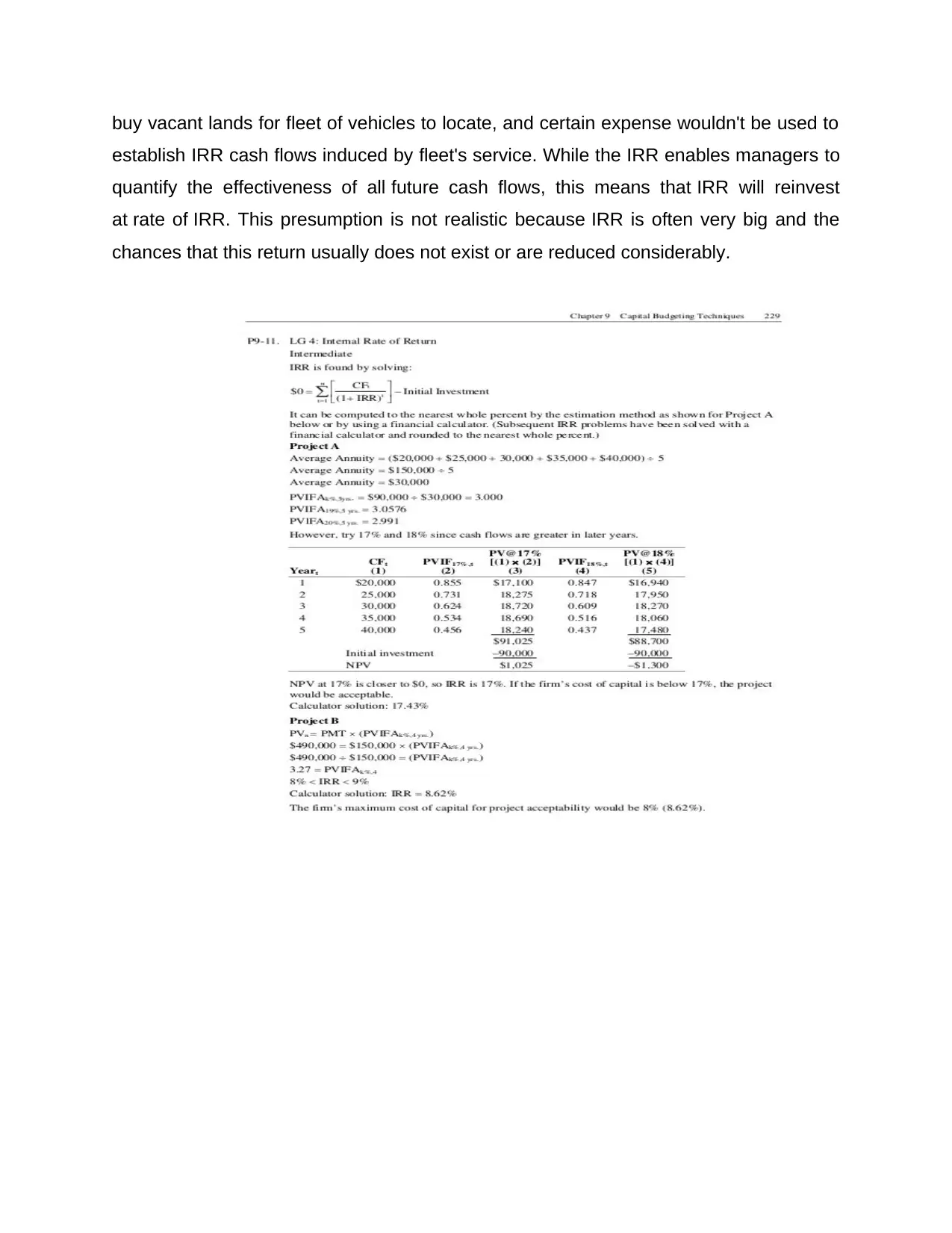
buy vacant lands for fleet of vehicles to locate, and certain expense wouldn't be used to
establish IRR cash flows induced by fleet's service. While the IRR enables managers to
quantify the effectiveness of all future cash flows, this means that IRR will reinvest
at rate of IRR. This presumption is not realistic because IRR is often very big and the
chances that this return usually does not exist or are reduced considerably.
establish IRR cash flows induced by fleet's service. While the IRR enables managers to
quantify the effectiveness of all future cash flows, this means that IRR will reinvest
at rate of IRR. This presumption is not realistic because IRR is often very big and the
chances that this return usually does not exist or are reduced considerably.
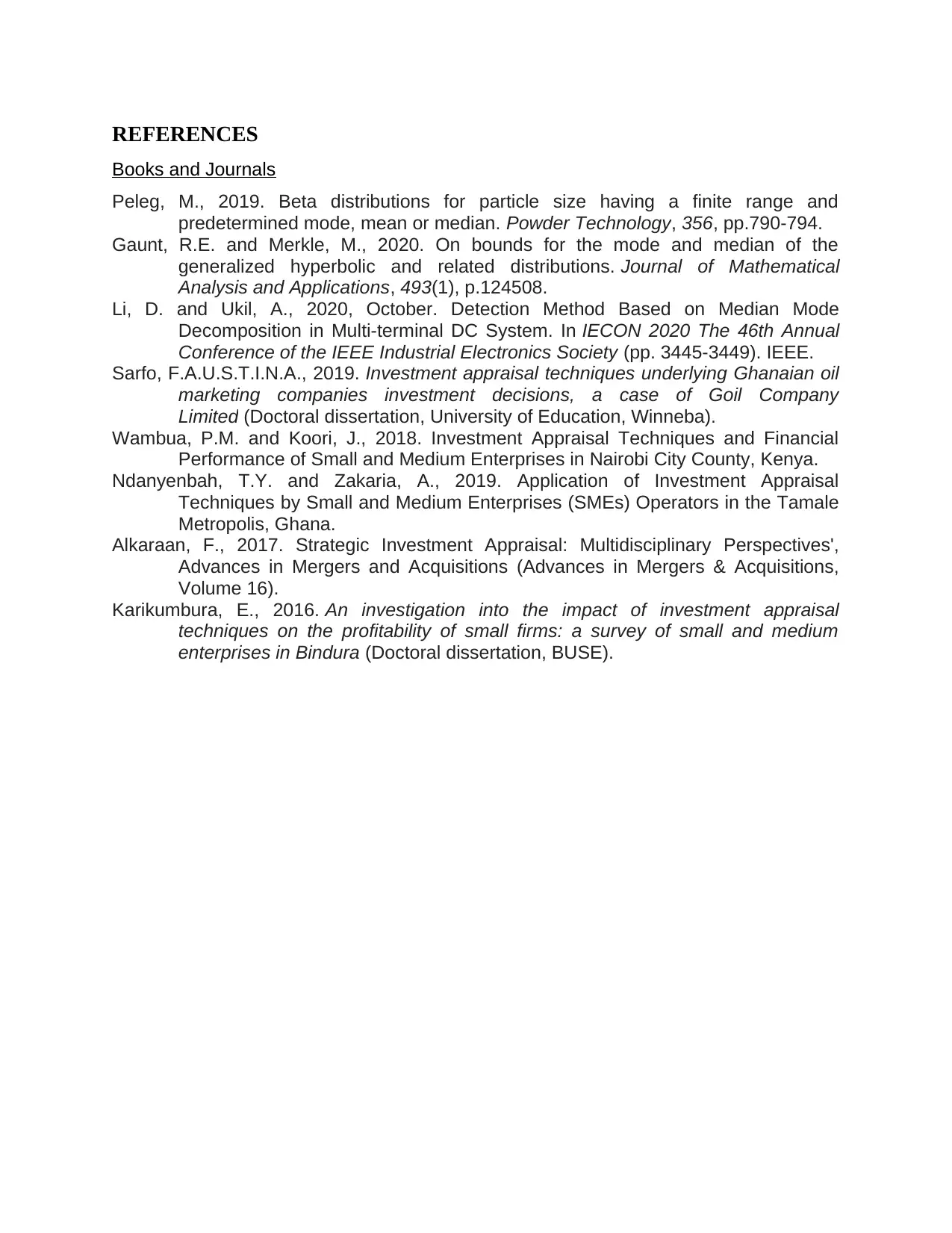
REFERENCES
Books and Journals
Peleg, M., 2019. Beta distributions for particle size having a finite range and
predetermined mode, mean or median. Powder Technology, 356, pp.790-794.
Gaunt, R.E. and Merkle, M., 2020. On bounds for the mode and median of the
generalized hyperbolic and related distributions. Journal of Mathematical
Analysis and Applications, 493(1), p.124508.
Li, D. and Ukil, A., 2020, October. Detection Method Based on Median Mode
Decomposition in Multi-terminal DC System. In IECON 2020 The 46th Annual
Conference of the IEEE Industrial Electronics Society (pp. 3445-3449). IEEE.
Sarfo, F.A.U.S.T.I.N.A., 2019. Investment appraisal techniques underlying Ghanaian oil
marketing companies investment decisions, a case of Goil Company
Limited (Doctoral dissertation, University of Education, Winneba).
Wambua, P.M. and Koori, J., 2018. Investment Appraisal Techniques and Financial
Performance of Small and Medium Enterprises in Nairobi City County, Kenya.
Ndanyenbah, T.Y. and Zakaria, A., 2019. Application of Investment Appraisal
Techniques by Small and Medium Enterprises (SMEs) Operators in the Tamale
Metropolis, Ghana.
Alkaraan, F., 2017. Strategic Investment Appraisal: Multidisciplinary Perspectives',
Advances in Mergers and Acquisitions (Advances in Mergers & Acquisitions,
Volume 16).
Karikumbura, E., 2016. An investigation into the impact of investment appraisal
techniques on the profitability of small firms: a survey of small and medium
enterprises in Bindura (Doctoral dissertation, BUSE).
Books and Journals
Peleg, M., 2019. Beta distributions for particle size having a finite range and
predetermined mode, mean or median. Powder Technology, 356, pp.790-794.
Gaunt, R.E. and Merkle, M., 2020. On bounds for the mode and median of the
generalized hyperbolic and related distributions. Journal of Mathematical
Analysis and Applications, 493(1), p.124508.
Li, D. and Ukil, A., 2020, October. Detection Method Based on Median Mode
Decomposition in Multi-terminal DC System. In IECON 2020 The 46th Annual
Conference of the IEEE Industrial Electronics Society (pp. 3445-3449). IEEE.
Sarfo, F.A.U.S.T.I.N.A., 2019. Investment appraisal techniques underlying Ghanaian oil
marketing companies investment decisions, a case of Goil Company
Limited (Doctoral dissertation, University of Education, Winneba).
Wambua, P.M. and Koori, J., 2018. Investment Appraisal Techniques and Financial
Performance of Small and Medium Enterprises in Nairobi City County, Kenya.
Ndanyenbah, T.Y. and Zakaria, A., 2019. Application of Investment Appraisal
Techniques by Small and Medium Enterprises (SMEs) Operators in the Tamale
Metropolis, Ghana.
Alkaraan, F., 2017. Strategic Investment Appraisal: Multidisciplinary Perspectives',
Advances in Mergers and Acquisitions (Advances in Mergers & Acquisitions,
Volume 16).
Karikumbura, E., 2016. An investigation into the impact of investment appraisal
techniques on the profitability of small firms: a survey of small and medium
enterprises in Bindura (Doctoral dissertation, BUSE).
1 out of 13
Related Documents
Your All-in-One AI-Powered Toolkit for Academic Success.
+13062052269
info@desklib.com
Available 24*7 on WhatsApp / Email
![[object Object]](/_next/static/media/star-bottom.7253800d.svg)
Unlock your academic potential
© 2024 | Zucol Services PVT LTD | All rights reserved.





